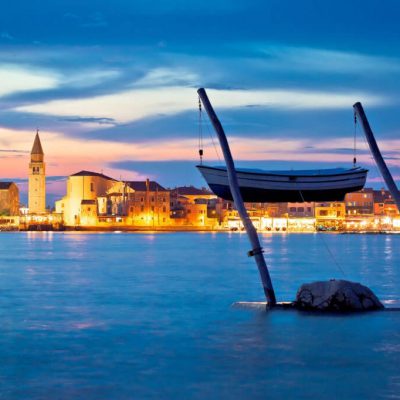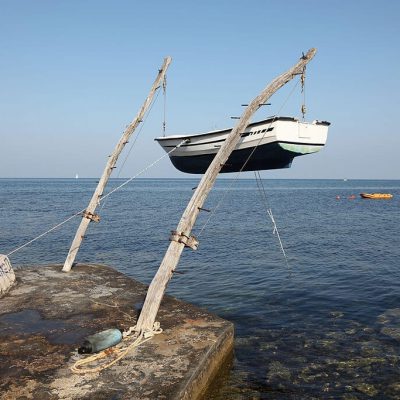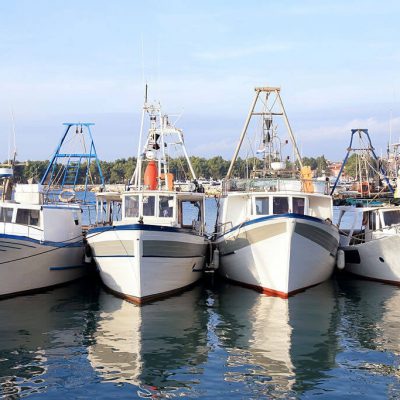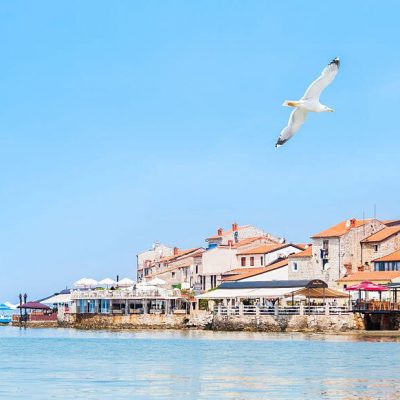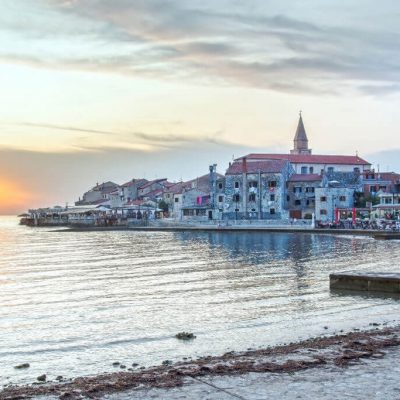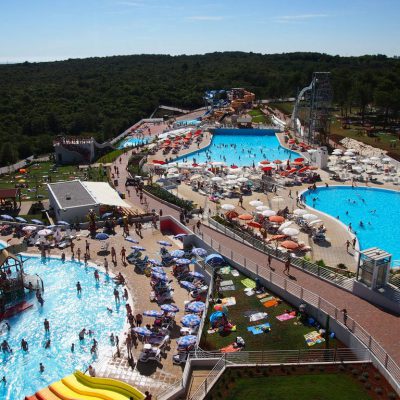Umag, a small town and port on the north-western coast of Istria, is known as ‘Croatia’s gateway to Europe’. It also has the reputation of the Istrian sports centre, since as the host of the ATP tournament for many years now, it attracts numerous top world tennis players. With superb accommodation conditions, a wellness oasis, casino bars, traditional festivals, many cultural events and a rich gastronomic offer you will really enjoy Umag.
About
Umag, a small town and port on the north-western coast of Istria, is known as ‘Croatia’s gateway to Europe’. It also has the reputation of the Istrian sports centre, since as the host of the ATP tournament for many years now, it attracts numerous top world tennis players. With superb accommodation conditions, a wellness oasis, casino bars, traditional festivals, many cultural events and a rich gastronomic offer you will really enjoy Umag.
Its beneficial features were recognized already by the Romans who turned it into their summer residence. The magnificence and splendour of those times today is reflected in many Venetian houses in the old part of Umag.
At a distance of only 40 kilometres from Trieste, 150 kilometres from Ljubljana, the capital of Slovenia and 50 nautical miles from Venice, Umag is a favourite holiday destination with extraordinary excursion possibilities. Umag’s hinterland offers newly discovered tourist attractions like mountaineering, caving and other chances for adventure enthusiasts.
Useful info
Tourist information office
Umag’s tourist information office is at JB Tita 3/2. They can give you brochures and maps as well as information on sports opportunities and excursions.
*The mixture of Mediterranean and Alpine climate is a special feature, making the summer heat bearable for elderly people, too, while the nights offer a pleasant sleep without a sweltering heat. This mixture of Mediterranean and Alpine air is very favourable for persons with cardiac and pulmonary disorders. Very rarely the temperature falls below 15 °C, and the snow has been recorded very rarely. The sea water is crystal clear and suitable for swimming from May to October.
*Health centre is at Edoardo Pascali 3.
* ACI marina Umag is located in the northern part of the port of Umag, close to Hotel Adriatic. It operates during the whole year. Capacity: 518 berths on sea and 120 on land. At guests’ disposal are all necessary additional facilities: front office, exchange office, restaurant, bathtubs, shops, nautical services, a 50-ton crane and a parking lot with petrol station in the immediate vicinity. This marina is one of the major ADAC and OAMT info points.
Postal service
The main post office is at 1. svibnja 1.
Banks
Zagrebačka banka d.d.
Jadranska 18
Istarska kreditna banka d.d.
Ernesta Miloša 1
Privredna banka Zagreb d.d.
Jadranska 20
OTP banka Hrvatska d.d.
Trgovačka 2
Erste & Steiermarkische bank d.d.
Trgovačka 2A
Raiffeisen bank Austria d.d.
Obala J.B.Tita 4
Hypo Alpe Adria bank d.d.
Trgovačka 1B
Traffic
Umag is the first nautical gate from Central Europe to Croatia, located in an attractive bay with one of the most prestigious ACI marinas awarded with a Blue Flag – the European standard for quality of beaches and marinas.
You can reach Umag quickly and easily from Trieste, Venice, Zagreb or Ljubljana. The trip from Graz, Innsbruck, Munich and Budapest is only a little longer. The Umag-Novigrad cluster is accessible to the entire world via airports in Pula, Zagreb and Venice. You can also
arrive via smaller airports in Trieste, Rijeka and Ljubljana or by bus, which will take you to stations in Umag, Rijeka, Pula, Trieste and Zagreb. The main bus station is at Joakima Rakovca 11.
Also, you can reach Umag by ships headed to Trieste, Rijeka or Pula. You can also access the region by train to Rijeka and Trieste or Istrian railway stations in Buzet, Pazin and Pula. A mini tourist train connects Umag with Katoro.
Visit
What is now a peninsula used to be an island, and the settlement itself was situated at the end of the port of Umag. The town walls with the town gate and a draw-bridge were built in the 10th century. They have been partially preserved in the south-western part, next to the Town Museum (which was one of the defence towers with the battlements in the shape of ‘a swallow’s tail’, which can still be seen from the sea side).
At the entrance to the historic core stands the church of St. Roche, built after the plague epidemic in 1507. In the interior of the church there is a remarkable oil-painted wooden ceiling from the 18th century.
The public cistern from 1677 was renovated in 1780. Behind the Parish Church, there is a metal ball, impressed into the wall, east of the abscissa: historians say that it is a cannon-ball fired by a ship from Genoa in 1810. The ancient houses decorated by lovely windows, narrow streets, coats of arms and inscriptions make a recognizable part of Umag and can be found on the western side of the town.
The parish church of The Assumption of Virgin Mary and St. Peregrine, the patron saint of the city of Umag, was built after the design of the architect Filippo Dongeti from Piran. The late baroque façade remained unfinished. On the interior side of the church entrance there is an immured depiction of St. Peregrine from 14th century. The fresco on the church ceiling is attributed to Giuseppe Bernardino Bison from Palmanova. On the main altar there are the statues of St. Peregrine and St. Nicefor.
Recreation
Only a few kilometres from the sea you will find real highlands where you can enjoy riding on some of the most attractive biking trails (with or without signs) which take you through the unbelievably beautiful and almost intact landscapes to the nearby medieval small towns, located on hilltops and offering a view of nearby villages, hamlets and the blue sea. Apart from the biking trails you will find mountaineering, hiking, riding trails and wine roads.
Umag and its hinterland called the Bujština region have traditionally been well known for hunting as an integral part of its tourist offer (hare, pheasant, boar, doe etc.), especially for foreign hunters.
Umag offers highly attractive possibilities for amateur and professional diving thanks to its ecologically clean and clear sea and rich flora and fauna of the underwater world.
Umag has 61 tennis courts, 55 of which are clay, 4 concrete and 2 indoor courts on the carpet. They are excellently located – by the sea and close to the hotels, villas and apartments. They are surrounded by pine forest and harmoniously included in the environment. Some of them are covered and most have special seating space.
Gastro
The north-western region of Istria, thanks to its diverse natural riches on a relatively small space, is an ideal destination for an interesting vacation with an exquisite gastronomical experience. The region offers a fish-rich shore and inland hills filled with truffles and wild flora.
Wild asparagus is definitively one of the most appreciated wild-grown cultures which flourishes in Istria, and is picked from the middle of March till the end of April. In that period in the north-western area of Istria “The days of Asparagus” are held, when numerous restaurants and taverns offer various specialties with this tasty and extremely healthy plant.
Wines
Teran is a very old grape variety, one of the most distributed red grape variety in Istria. According to the available written records, teran was first mentioned 600 years ago. It was written that teran was used as a gift to emperor’s ambassadors in 1390, who were given 20 ceramic bottles, after that, in 1408 teran was given as a gift to the ambassador of Venice, and in 1411 the ambassador of Austria. These facts certainly add to the value and quality of this Istrian red wine.
Malvasia, whose name comes from the Greek city Monamvasia (located on the Peloponnese peninsula), is a grape variety at least 2000 years old. It is believed that Venetian wine traders brought it to Istria in the 14th century. When talking about malvasia, we usually refer to a white grape variety, although there is malvasia nera (red variety) grown mostly in the Italian regions of Piemonte and Puglia.



